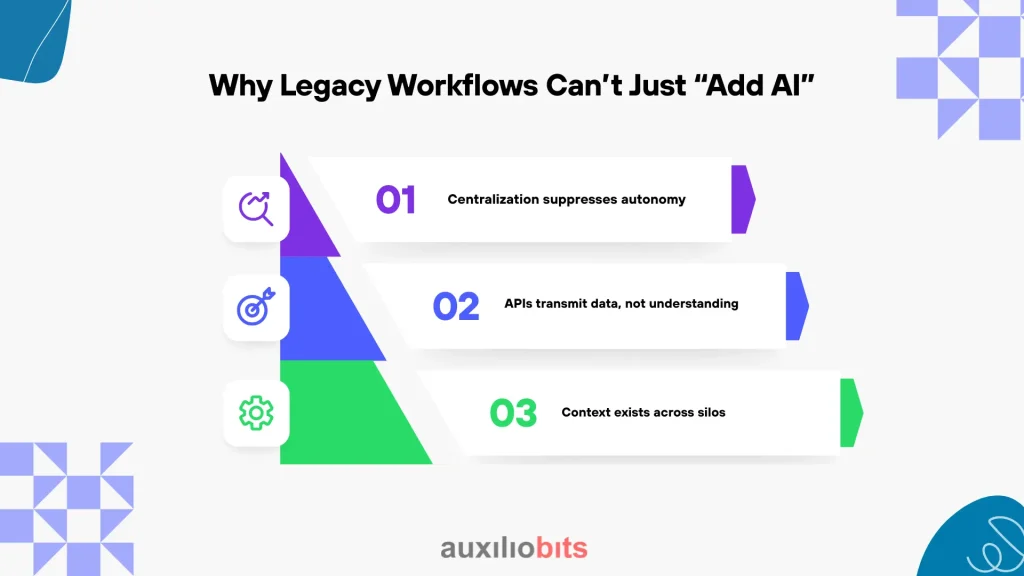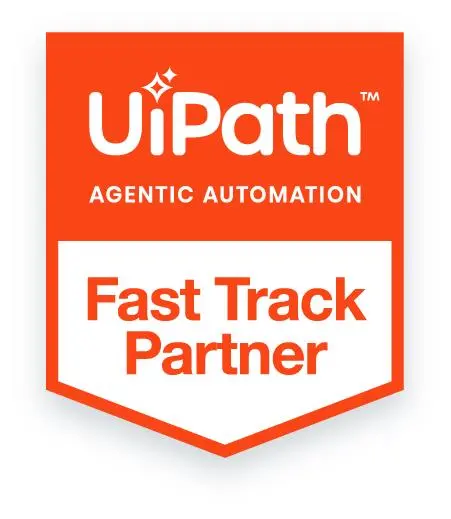
Key Takeaways
- Agentic workflows transform enterprise automation by introducing reasoning, autonomy, and collaboration among intelligent agents rather than rigid rule-based execution.
- A true digital nerve center mirrors biological intelligence—perceiving changes, reasoning about them, and executing responses reflexively across systems.
- Legacy workflows can’t simply bolt on AI; they require decentralized reasoning, semantic understanding, and cross-silo context to behave intelligently.
- The most powerful ROI metric is decision latency—how quickly an organization detects, understands, and responds to change, not just time or cost savings.
- Enterprises are evolving from machines to organisms, where systems, agents, and humans operate as a living, adaptive network capable of self-correction and continuous learning.
Walk into any enterprise operations room today, and you’ll find the same paradox repeating itself. Every process is digitized, every function instrumented, and yet decisions crawl through the system like syrup. Dashboards glow with live data, but reactions depend on someone noticing, interpreting, and triggering the next step. We have digital muscles—ERP, CRM, SCM — but no digital reflexes.
That’s where agentic workflows enter the scene. They’re not about replacing human decision-makers or adding a shiny new automation layer. They’re about giving enterprises a nervous system—a structure that senses change, understands it, and responds intelligently.
This isn’t just a new buzzword. It’s an architectural rethinking of how work happens.
Also read: Change management: aligning people, process, and agentic automation adoption
Why the Nerve Center Analogy Fits
When technologists talk about a “digital nerve center,” they usually mean some form of control room—a dashboard that aggregates metrics across systems. But a true nerve center does more than display information. It perceives, decides, and acts.
Biologically speaking, nerves don’t ask for permission. The moment you touch something hot, the reflex bypasses conscious thought and withdraws your hand. Imagine a supply chain with that kind of instinct. A shipment delay triggers automatic rerouting. A pricing anomaly prompts an immediate cross-check with sales data. A compliance gap flags itself before regulators do.
That’s what agentic workflows promise—reflexive enterprise behavior.
From Rules to Reasoning
Traditional automation works beautifully in stable environments. RPA bots click buttons, scripts update fields, and APIs shuttle data from one system to another. But give them a slightly ambiguous situation—a missing field, an unexpected data pattern—and they freeze.
Agentic workflows don’t freeze. They think.
Instead of “if-this-then-that,” they operate on intent. Each agent is aware of its goal, understands its environment, and coordinates with peers to achieve it.
Let’s illustrate this shift with a familiar example: customer refunds.
In the traditional setup:
- A bot checks the claim form.
- If the data matches the rules, it issues the refund.
- Otherwise, it raises an exception for manual review.
In an agentic system:
- A Customer Agent looks beyond the form—into sentiment analysis from support tickets, historical behavior, and fraud indicators.
- A Finance Agent assesses cash flow implications.
- A Policy Agent ensures regional compliance.
- Together, they negotiate and agree on the next step—whether to refund, delay, or escalate.
What’s changed isn’t the output, but the process of arriving there. The decision becomes distributed, contextual, and adaptive.
The Architecture Beneath the Metaphor
Agentic workflows rest on three fundamental layers—each playing a distinct role in this digital nervous system.
- Perception Layer—The sensory system of the enterprise. It captures raw signals from operational systems, APIs, IoT sensors, and communication streams. These could be events like “inventory dropped below threshold,” “supplier missed a milestone,” or “ticket backlog increased by 20%.”
- Cognition Layer—The reasoning engine. This is where agents interpret meaning. They don’t see isolated alerts; they recognize patterns, infer intent, and predict consequences. For instance, a spike in support tickets following a price update could signal customer confusion—not just volume overload.
- Execution Layer – The motor response. Once agents decide what action aligns with goals, they execute—updating systems, sending instructions, or triggering further workflows. Crucially, they can adjust plans on the fly if new data contradicts prior assumptions.
Together, these layers mimic biological coherence. They allow perception, thought, and motion to align—producing behavior, not just process execution.
Why Legacy Workflows Can’t Just “Add AI”
Many organizations are trying to retrofit intelligence into old systems by sprinkling machine learning on top of existing workflow tools. The results are often cosmetic. The system gets better analytics, but the behavior doesn’t evolve.
There are three fundamental reasons for this:

- Centralization suppresses autonomy. Traditional workflow engines rely on predefined orchestration. Every step is mapped, every exception codified. Agents, on the other hand, need decentralized reasoning—room to decide locally while aligning globally.
- APIs transmit data, not understanding. Legacy integrations let systems exchange fields, not meaning. Agentic models depend on semantic understanding—recognizing that “client,” “customer,” and “account holder” may describe the same entity.
- Context exists across silos. Real reasoning needs a panoramic view. Finance data alone doesn’t tell you why a shipment is delayed. Marketing metrics can’t explain production downtime. Agents must merge perspectives across functions.
Coordination Without Command
One of the hardest problems in multi-agent environments is preventing chaos. Full autonomy sounds great—until two agents pursue conflicting goals. The solution isn’t to reimpose central control but to design principles of coordination.
A few patterns are proving effective:
- Goal-Driven Collaboration: Agents share overarching goals rather than fixed instructions. A logistics network might define a collective target—maximize on-time delivery—and let individual agents choose tactics that serve it.
- Negotiation Mechanisms: Borrowed from economics, agents can “bid” for tasks based on capacity or confidence. This self-organizing approach distributes work efficiently without explicit scheduling.
- Role-Bounded Autonomy: Each agent has a defined sphere—procurement, finance, or compliance—ensuring decisions stay relevant but connected through a shared state.
Imagine a logistics firm. A Fleet Agent detects a truck breakdown. It negotiates with a Warehouse Agent to reassign delivery, while a Customer Agent updates expected timelines and adjusts compensation policy. No one coordinates this manually. The workflow emerges through interaction.
That’s not orchestration. That’s collaboration at machine speed.
Case Study: Procurement as a Living System
Take a mid-sized manufacturing company that manages hundreds of component suppliers. The procurement department is notorious for firefighting—dealing with missed shipments, fluctuating prices, and endless vendor emails.
Now, layer in agentic workflows:
- A Supplier Agent continuously evaluates performance, integrating shipment logs, quality reports, and market data.
- A Procurement Agent matches orders dynamically against production needs.
- A Finance Agent keeps an eye on currency rates and budget constraints.
- A Sustainability Agent validates compliance with ESG commitments.
When a supplier misses a delivery, the Supplier Agent triggers recalibration. The Procurement Agent identifies alternates. The Finance Agent reforecasts the cost impact. The Sustainability Agent ensures substitutes meet standards.
This happens without a manager calling a meeting or sending an email chain. The workflow breathes—sensing, reasoning, and adapting.
Such systems are already being tested in advanced manufacturing and aerospace sectors, often layered on top of existing ERP ecosystems via micro-agent frameworks.
The Technical Backbone
Building this kind of autonomy requires an invisible but powerful substrate. Key ingredients include:
- Semantic Data Graphs: They let agents understand relationships—not just raw fields. Instead of tabular joins, the enterprise runs on meaning: “order belongs to customer,” “vendor supplies component,” and so on.
- Shared Memory Spaces: Agents need a persistent context. Some use vector databases; others rely on distributed “blackboards” where agents post and retrieve state information.
- Policy and Guardrail Engines: Governance doesn’t vanish. It simply becomes programmable—defining what agents may do, under what confidence level, and within what risk envelope.
- Inter-Agent Communication Protocols: Standards like MCP (Message Coordination Protocol) or AICL (Agent Interaction and Communication Language) define how agents exchange intent, not just JSON payloads.
These aren’t flashy technologies. They’re the neural wiring that makes the “brain” function.
Humans Still Matter—Just Differently
Despite all the autonomy rhetoric, agentic workflows don’t eliminate humans. They reposition them.
Humans become strategic supervisors rather than micro-operators. They set goals, interpret reasoning traces, and teach agents new concepts. Instead of “approving” every transaction, they review how agents reached decisions and adjust policy boundaries.
In practical terms:
- A finance manager might analyze why an agent delayed payments to certain vendors and tweak its risk model.
- A supply chain lead could review agent-generated simulations before committing to a logistics re-route.
The relationship becomes symbiotic—the system acts, and humans refine their judgment.
This reframes digital work. The analyst of tomorrow isn’t clicking through spreadsheets; they’re training, mentoring, and auditing intelligent teammates.
When Autonomy Misfires
No system of distributed intelligence runs perfectly. The potential failure modes are fascinating—and sobering.
- Goal Drift: Agents optimizing local metrics (say, “reduce delivery cost”) may harm larger objectives (“maintain customer satisfaction”). Alignment protocols must ensure coherence.
- Feedback Loops: Autonomous agents reacting to each other’s decisions can create instability—much like financial algorithms amplifying market swings.
- Context Decay: If agents don’t update shared memory or lose synchronization, decisions become outdated or contradictory.
The mitigation? Traceability. Every agentic decision should come with an audit trail—what data it saw, what reasoning path it took, and why it acted.
The ROI Nobody Talks About
Enterprises often measure automation ROI in saved hours or reduced errors. Agentic workflows introduce a subtler but far more valuable metric: decision latency.
How long does it take the organization to detect, understand, and react to change?
In agentic architectures, that time collapses
- A global manufacturer reported a 37% reduction in downtime variance after deploying multi-agent maintenance scheduling—not because machines stopped failing, but because agents predicted conflicts and adjusted shifts in real time.
- A logistics firm using agentic routing cut customer delay notifications by 60%, as the system adapted routes preemptively.
- In finance operations, multi-agent reconciliation reduced end-of-month close times from five days to one.
The compounding effect of reflex—of continuous adaptation—beats static efficiency gains every time.
From Machines to Organisms
The real revolution here isn’t technical; it’s conceptual.
For decades, software architecture followed mechanical metaphors—systems as machines, engineers as operators, and processes as pipelines. Agentic workflows push us toward biological metaphors: systems as organisms, architects as ecologists, and processes as living interactions.
Organisms don’t run top-down scripts. They adapt, communicate, and sometimes fail gracefully. That’s precisely what enterprises must learn to do in a world where change is constant and data is infinite.
This shift unnerves traditional leaders because it reduces predictability. But predictability has always been an illusion in complex environments. What we need now is resilience — and resilience demands autonomy.
The digital transformation era gave companies their digital body. The agentic era is about building its mind—one capable of sensing, reasoning, and acting in real time.
Closing Thought
Creating the digital nerve center of tomorrow isn’t about deploying another platform or swapping humans for AI. It’s about connecting every digital limb of the enterprise through a cognitive mesh—a structure where agents, systems, and people share awareness and intent.
When that happens, enterprises won’t just automate tasks. They’ll cultivate reflexes. They’ll think across silos. And, perhaps most importantly, they’ll finally behave like intelligent organisms—not mechanical ones.








